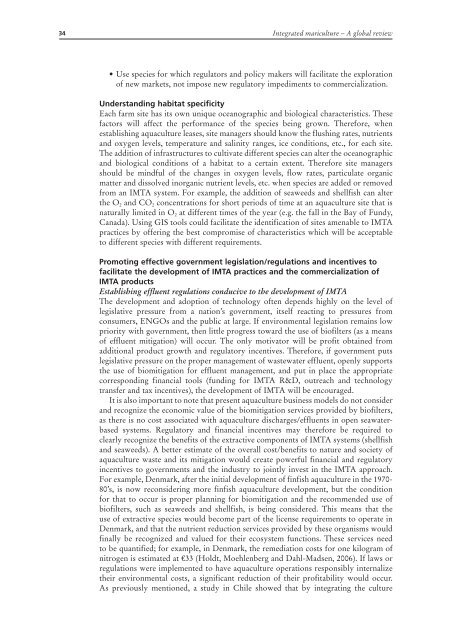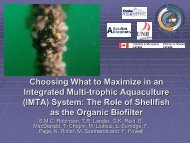Integrated multi-trophic aquaculture (IMTA) in marine temperate waters
Integrated multi-trophic aquaculture (IMTA) in marine temperate waters
Integrated multi-trophic aquaculture (IMTA) in marine temperate waters
Create successful ePaper yourself
Turn your PDF publications into a flip-book with our unique Google optimized e-Paper software.
34<br />
<strong>Integrated</strong> mariculture – A global review<br />
• Use species for which regulators and policy makers will facilitate the exploration<br />
of new markets, not impose new regulatory impediments to commercialization.<br />
Understand<strong>in</strong>g habitat specificity<br />
Each farm site has its own unique oceanographic and biological characteristics. These<br />
factors will affect the performance of the species be<strong>in</strong>g grown. Therefore, when<br />
establish<strong>in</strong>g <strong>aquaculture</strong> leases, site managers should know the flush<strong>in</strong>g rates, nutrients<br />
and oxygen levels, temperature and sal<strong>in</strong>ity ranges, ice conditions, etc., for each site.<br />
The addition of <strong>in</strong>frastructures to cultivate different species can alter the oceanographic<br />
and biological conditions of a habitat to a certa<strong>in</strong> extent. Therefore site managers<br />
should be m<strong>in</strong>dful of the changes <strong>in</strong> oxygen levels, flow rates, particulate organic<br />
matter and dissolved <strong>in</strong>organic nutrient levels, etc. when species are added or removed<br />
from an <strong>IMTA</strong> system. For example, the addition of seaweeds and shellfish can alter<br />
the O 2 and CO 2 concentrations for short periods of time at an <strong>aquaculture</strong> site that is<br />
naturally limited <strong>in</strong> O 2 at different times of the year (e.g. the fall <strong>in</strong> the Bay of Fundy,<br />
Canada). Us<strong>in</strong>g GIS tools could facilitate the identification of sites amenable to <strong>IMTA</strong><br />
practices by offer<strong>in</strong>g the best compromise of characteristics which will be acceptable<br />
to different species with different requirements.<br />
Promot<strong>in</strong>g effective government legislation/regulations and <strong>in</strong>centives to<br />
facilitate the development of <strong>IMTA</strong> practices and the commercialization of<br />
<strong>IMTA</strong> products<br />
Establish<strong>in</strong>g effluent regulations conducive to the development of <strong>IMTA</strong><br />
The development and adoption of technology often depends highly on the level of<br />
legislative pressure from a nation’s government, itself react<strong>in</strong>g to pressures from<br />
consumers, ENGOs and the public at large. If environmental legislation rema<strong>in</strong>s low<br />
priority with government, then little progress toward the use of biofilters (as a means<br />
of effluent mitigation) will occur. The only motivator will be profit obta<strong>in</strong>ed from<br />
additional product growth and regulatory <strong>in</strong>centives. Therefore, if government puts<br />
legislative pressure on the proper management of wastewater effluent, openly supports<br />
the use of biomitigation for effluent management, and put <strong>in</strong> place the appropriate<br />
correspond<strong>in</strong>g f<strong>in</strong>ancial tools (fund<strong>in</strong>g for <strong>IMTA</strong> R&D, outreach and technology<br />
transfer and tax <strong>in</strong>centives), the development of <strong>IMTA</strong> will be encouraged.<br />
It is also important to note that present <strong>aquaculture</strong> bus<strong>in</strong>ess models do not consider<br />
and recognize the economic value of the biomitigation services provided by biofilters,<br />
as there is no cost associated with <strong>aquaculture</strong> discharges/effluents <strong>in</strong> open seawaterbased<br />
systems. Regulatory and f<strong>in</strong>ancial <strong>in</strong>centives may therefore be required to<br />
clearly recognize the benefits of the extractive components of <strong>IMTA</strong> systems (shellfish<br />
and seaweeds). A better estimate of the overall cost/benefits to nature and society of<br />
<strong>aquaculture</strong> waste and its mitigation would create powerful f<strong>in</strong>ancial and regulatory<br />
<strong>in</strong>centives to governments and the <strong>in</strong>dustry to jo<strong>in</strong>tly <strong>in</strong>vest <strong>in</strong> the <strong>IMTA</strong> approach.<br />
For example, Denmark, after the <strong>in</strong>itial development of f<strong>in</strong>fish <strong>aquaculture</strong> <strong>in</strong> the 1970-<br />
80’s, is now reconsider<strong>in</strong>g more f<strong>in</strong>fish <strong>aquaculture</strong> development, but the condition<br />
for that to occur is proper plann<strong>in</strong>g for biomitigation and the recommended use of<br />
biofilters, such as seaweeds and shellfish, is be<strong>in</strong>g considered. This means that the<br />
use of extractive species would become part of the license requirements to operate <strong>in</strong><br />
Denmark, and that the nutrient reduction services provided by these organisms would<br />
f<strong>in</strong>ally be recognized and valued for their ecosystem functions. These services need<br />
to be quantified; for example, <strong>in</strong> Denmark, the remediation costs for one kilogram of<br />
nitrogen is estimated at €33 (Holdt, Moehlenberg and Dahl-Madsen, 2006). If laws or<br />
regulations were implemented to have <strong>aquaculture</strong> operations responsibly <strong>in</strong>ternalize<br />
their environmental costs, a significant reduction of their profitability would occur.<br />
As previously mentioned, a study <strong>in</strong> Chile showed that by <strong>in</strong>tegrat<strong>in</strong>g the culture



